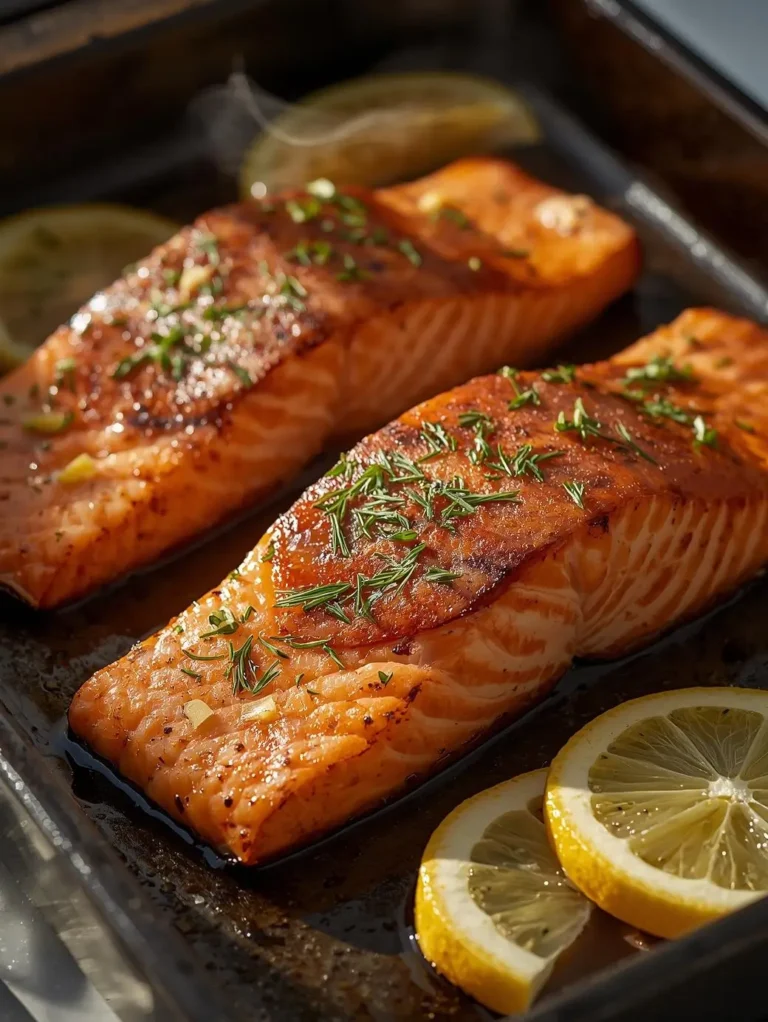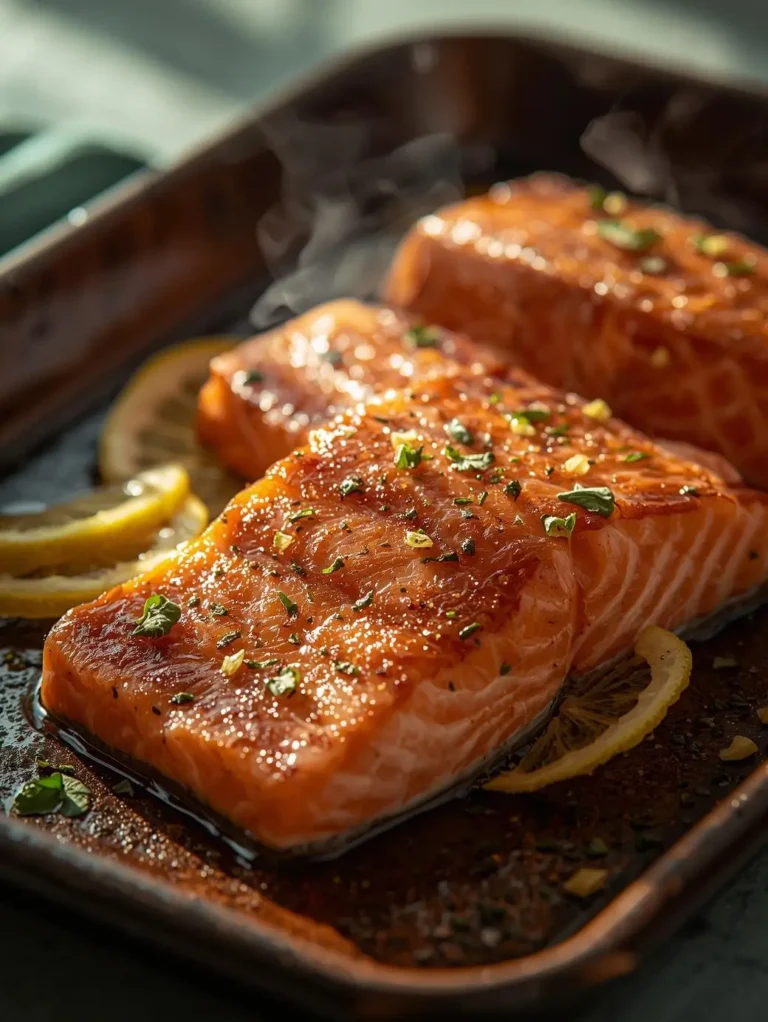Baked salmon is one of those rare dinners that feels special yet asks very little from you. With a sheet pan, a few pantry staples, and a reliable oven, you can turn a fillet into a silky, gently crisped centerpiece in under 20 minutes. If you’re new to cooking fish, this method is kind, predictable, and easy to repeat.
The best part is how forgiving it is. A light brush of fat, a pinch of salt, and steady heat do most of the work.
Why baking salmon works for first-timers
Pan searing can be dramatic, broiling can be intense, and grilling wants your full attention. Baking gives you steady heat that cooks from all sides. That steadiness means fewer flare ups, fewer surprises, and a high chance of success even if you peek into the oven a couple of times.
Baked salmon also carries flavor well and stays moist during cooking. It is rich, it holds moisture, and it prefers not to be overcomplicated. A squeeze of lemon and a good salt can be enough.
How to choose salmon at the store
If you see both wild and farmed salmon, know that each streams toward a slightly different result. Wild species like sockeye and coho are leaner and cook fast, with a clean, pronounced flavor. Farmed Atlantic salmon tends to be more marbled, stays moist a bit longer, and has a milder taste.
Skin on vs skinless is a style choice. Skin on protects the flesh, locks in moisture, and crisps nicely on a hot surface. Skinless makes slicing and plating straightforward. If you’re nervous about sticking, go with skin on and line your pan with parchment.
Fresh or frozen both work. Frozen fillets that were processed quickly after harvest can be excellent. Thaw them overnight in the fridge, still wrapped, on a plate. Pat dry before seasoning.
Gear and pantry check
You do not need much, which is great news on a weeknight. A rimmed sheet pan helps keep juices contained. Parchment or foil makes cleanup easy. A quick-read thermometer removes guesswork and is especially helpful when you are still learning your oven’s personality.
After you gather the basics for baked salmon, skim this short list so everything is at arm’s reach when the oven is hot.
- Salmon fillet, 1 to 1.5 pounds
- Olive oil or melted butter
- Salt and pepper
- Lemon wedges
- Rimmed sheet pan and parchment
- Quick-read thermometer
- Optional aromatics, sliced: lemon, garlic, herbs
The core method, step by step
Preheat your oven to 400°F and place a rack in the middle. Line a sheet pan with parchment. This temperature gives you gentle caramelization on the surface while keeping the center tender.
Pat the salmon dry with paper towels. Moisture on the surface fights browning, so do not skip this step. If the fillet has pin bones, feel along the center line and pull them with tweezers.
Brush or rub the fish with 1 to 2 tablespoons of olive oil or melted butter. Season with 1 teaspoon kosher salt per pound of salmon, plus several grinds of black pepper. If using aromatics, scatter thin lemon slices and a few smashed garlic cloves around the fillet. A handful of herb sprigs can go on top.
Bake until the thickest part reaches 125 to 130°F for medium, or until the flesh just flakes when pressed lightly with a fork. Most 1-inch-thick fillets take 10 to 14 minutes at 400°F. Pull the pan, rest the fish 5 minutes, and spoon any pan juices over the top.
That rest is not just ceremony. It lets juices redistribute so each bite is silky rather than dry.
Time and temperature reference
Different fillets cook at slightly different rates. Thickness is the best guide, followed by your preferred doneness. Use this table as a starting point, then adjust to your oven.
| Salmon thickness (at thickest point) | Oven temp | Time range | Pull temp (internal) | Texture result |
|---|---|---|---|---|
| 3/4 inch | 400°F | 8 to 10 minutes | 120 to 125°F | Very tender, slightly translucent center |
| 1 inch | 400°F | 10 to 14 minutes | 125 to 130°F | Juicy, medium, flakes cleanly |
| 1 1/4 inches | 400°F | 14 to 18 minutes | 125 to 130°F | Moist, firmer flakes |
| 1 inch | 375°F | 12 to 16 minutes | 125 to 130°F | Gentle, softer surface browning |
| 1 inch | 425°F | 8 to 12 minutes | 125 to 130°F | Faster, deeper surface color |
Remember that carryover heat will raise the temperature a couple of degrees while resting.
A basic recipe you can memorize
Here is a simple format that works with any fillet.
- Heat the oven to 400°F. Line a sheet pan with parchment.
- Dry the salmon. Brush with 1 to 2 tablespoons olive oil or butter before placing your baked salmon in the oven.
- Season with 1 teaspoon kosher salt per pound, plus pepper.
- Bake the baked salmon for 10 to 14 minutes per 1-inch thickness, until 125 to 130°F at the center.
- Rest 5 minutes. Finish with lemon juice and a drizzle of oil.
Once you run through this a few times, it becomes muscle memory.
Flavor paths that always work
Simple does not mean boring. You can switch the flavor profile by changing just a few ingredients. Keep the same base method, then try one of these:
Before you jump into the ideas, remember that salt quantity stays the same, and you can add fresh herbs at the end for brightness.
- Lemon garlic: Zest 1 lemon and mix with 1 tablespoon minced garlic, 2 tablespoons olive oil, and black pepper. Spread over the fillet, then bake. Finish with lemon juice and chopped parsley.
- Maple Dijon: Stir 2 tablespoons pure maple syrup with 1 tablespoon Dijon mustard, 1 tablespoon olive oil, and a pinch of chili flakes. Brush on the fish before baking. Finish with a sprinkle of flaky salt.
- Herb and spice: Combine 1 teaspoon smoked paprika, 1 teaspoon dried oregano, 1/2 teaspoon ground coriander, and 2 tablespoons olive oil. Rub onto the fillet. Finish with chopped dill and a squeeze of orange.
Common mistakes and how to avoid them
Overcooking is the big one. Pull the fish when the center reads 125 to 130°F or when a fork twist reveals moist flakes. If you are nervous, check early, then add a minute or two as needed.
Skipping the pat-dry step leaves a moist surface and pale color. Use a paper towel and be thorough, especially on the top.
Underseasoning is common with larger fillets. A general guide is 1 teaspoon kosher salt per pound of fish. If using table salt, use a bit less.
Crowding the pan can trap steam. Leave some space around the fillet so the surface can dry and brown.
Skin-on tips
If you have a skin-on fillet, bake it skin side down. The skin acts like a natural shield and makes it easier to lift slices of baked salmon without breaking the flesh. After baking, you can slide a thin spatula between skin and flesh and leave the skin behind on the parchment.
Want crisp skin from the oven without searing on the stove when making baked salmon? Preheat the pan for 5 minutes, oil the parchment lightly, and set the fish on the hot surface. The skin will firm up nicely while the top stays moist.
What to serve alongside
Bright, crunchy sides balance the richness of salmon. Think about color and texture. A salad with a sharp vinaigrette, roasted vegetables, or a simple grain bowl lets the fish shine while rounding out the plate.
Quick sauces help too. A 30 second yogurt sauce with lemon and dill, a spoon of pesto, or a garlicky tahini drizzle can turn the same base recipe into something new.
Nutrition and sourcing notes
Salmon is packed with protein and omega 3 fats that support heart health. Baking uses relatively little added fat, which keeps the dish light while still satisfying. Pairing it with greens and whole grains creates a balanced plate that feels generous rather than heavy.
When choosing salmon, look for firm flesh and a clean smell. If you care about sustainability, check labels from reputable programs, or ask the fishmonger about origin and seasonality. Frozen can be a smart option when the fresh case looks tired, and it often costs less.
Make it ahead friendly
You can season the salmon up to a few hours in advance and hold it in the fridge, uncovered, which helps dry the surface. If using a sugary glaze like maple, wait to brush it on until just before baking so it does not draw out moisture, keeping the salmon moist.
Leftovers keep well. Store cooked salmon in an airtight container in the fridge for up to 3 days. Eat it cold over greens with a lemony dressing, fold it into a grain bowl, or flake it into warm pasta with capers and herbs.
Troubleshooting quick hits
Things go wrong in kitchens, and that is normal. Here are a few fast fixes that solve the most common hiccups.
- Dry texture: Pull earlier next time, and rely on the thermometer. For the batch you have, flake the salmon and fold it with a spoon of olive oil and lemon to restore moisture.
- Strong aroma: Rub the fillet with lemon and pat dry before seasoning. Baking with citrus slices and herbs softens assertive notes.
- Sticking to the pan: Use parchment, not bare metal. Let the fish rest a minute after baking, then slide a thin spatula under the skin or along the parchment.
A few smart add ons
If you want a one pan dinner, add trimmed asparagus spears or halved cherry tomatoes to the sheet pan. Toss them with a bit of oil and salt before nestling the salmon in the middle. Most vegetables that cook in 10 to 15 minutes are fair game.
Craving a bit of crunch on top without frying? Mix panko with olive oil, lemon zest, and a pinch of salt, then scatter over the salmon for the final 5 minutes of baking. It toasts quickly and gives a satisfying contrast.
Short FAQ
Can I bake salmon straight from frozen? You can. Bake at 400°F for 20 to 25 minutes for a 1-inch-thick fillet, seasoning halfway through once the surface has thawed. The texture is slightly firmer but still tasty.
Do I need to flip salmon in the oven? No. Leave it skin side down or flat on the parchment. Flipping increases the risk of breaking the fillet.
What internal temperature is safe? The USDA lists 145°F, which yields a firm texture. Many cooks prefer pulling at 125 to 130°F for a juicier result. Choose what fits your taste and comfort.
How do I scale this for a crowd? Use two sheet pans and rotate halfway through baking. Season fillets the same way and plan on 6 ounces per person for a generous serving.
Salmon rewards simple technique and a bit of attention. Once you trust your oven and your timing, you have a reliable dinner that feels fresh every single time.
Print
Easy Baked Salmon Recipe for Beginners
A juicy, flavorful baked salmon recipe seasoned with lemon, garlic, and herbs. Healthy, quick, and perfect for a weeknight dinner.
- Total Time: 25
- Yield: 4
Ingredients
4 salmon fillets
2 tbsp olive oil
2 tbsp lemon juice
3 garlic cloves, minced
1 tsp paprika
1 tsp dried oregano
1 tsp salt
1/2 tsp black pepper
Lemon slices
Fresh parsley (optional)
Instructions
Preheat oven to 400°F / 200°C.
Mix olive oil, lemon juice, garlic, paprika, oregano, salt, and pepper.
Brush mixture over salmon fillets and top with lemon slices.
Bake 12–15 minutes until the salmon flakes easily.
Garnish with parsley and serve.
- Prep Time: 10
- Cook Time: 15
- Category: Dinner
- Cuisine: American
- Diet: Vegetarian


